Overweight, or obesity, is as much of a problem in rabbits as it is in any other species, especially domestic rabbits. Obese rabbits cannot function normally due to their large size and lower body fat percentage. Although some breeds of rabbits, including the dwarf rabbit, are at higher risk for obesity due to their small size and inactivity, it most often occurs in middle-aged rabbits that are caged and independent. of their sex.
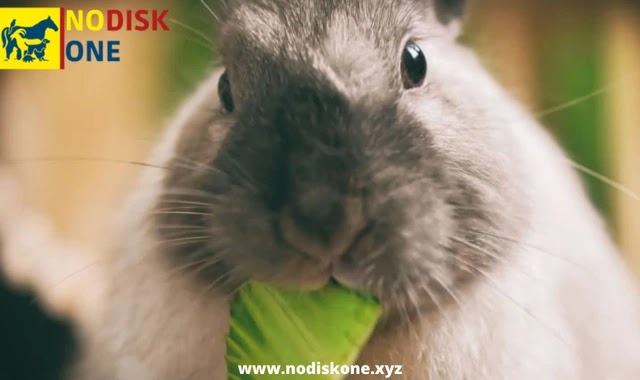 |
| Rabbit Obesity: Is It An Issue If Your Rabbit Is Obese? |
It can be difficult for some people to recognize that their rabbit is overweight. When weight gain happens gradually, you may barely notice the change. In many cases, it will be your veterinarian who will recognize and report the problem. We are aware that obesity in humans is associated with a wide range of health issues and complications. The same is true of our pets. Neutered animals are especially likely to gain weight.
By feeling for their ribs, spine, and hips, you can determine whether your rabbit is obese. You must assist your rabbit in losing weight if finding these bones is challenging due to a layer of thick fat. You can help your rabbit get healthy again and live a long life by encouraging them to eat well and get plenty of exercise.
The good news is that changing your rabbit's diet and encouraging more exercise can frequently reduce obesity in rabbits. You can assist your rabbit in losing weight and regaining his or her happiness and health.
This is an informative article. Nodisk One is not permitted to make a diagnosis or recommend any form of veterinary care. If your pet is in pain or ill, we recommend that you take him to the vet.
How To Identify An Obese Rabbit?
First, you may be wondering how to tell if your rabbit is fat. If your rabbit is severely obese, you can probably tell just by looking at it. But it's not always so simple, especially for rabbits that have long fur coats, hiding their body shapes.
Body Condition Scoring Chart
Due to the significant differences we can find between rabbit breeds, there is no BMI that we can measure to determine if our rabbits are overweight. Professionals will use the Body Condition Scoring (BCS) chart to determine if an animal is obese or underweight.
1. Emaciated: FNo fat, with a visible spine, hips and ribs that feel pointed to the touch. There will likely be a loss of muscle mass and there may be sunken areas around the bunnies behind.
2. Thin: A very thin layer of fat. The rabbit's spine, hips and ribs feel easily and are a little sharp to the touch.
3. Ideal Weight: There is a layer of healthy fat, but no bulging areas. The spine, hips, and ribs can be felt, but are rounded and not sharp to the touch.
4. Overweight: There is a thick layer of fat that makes it difficult to feel the ribs, hips, and spine. There may be a few more fat folds and the bottom will start to round out the sides.
5. Obese: The hips, spine, and ribs are very difficult or impossible to feel. Additionally, the stomach sags and there are numerous layers of visible fat. The rabbit will be rounded on the sides around its buttocks and abdomen.
The Profile Of The Rabbit
An underweight rabbit will have sharp ribs, spine, shoulders and hips with little or no fat. An overweight rabbit will have rounded buttocks and chest with sagging fat folds. Ribs, spine, shoulders and hips will be difficult or impossible to hit.
 |
| The Profile Of The Rabbit |
The first thing to do is to check your rabbit's profile. Check to see if they are obviously obese by looking at them from the side and from above. You will be looking for a visibly rounded belly and buttocks. The rabbit may even have diapers or rolls of fat.
If your rabbit is a long-haired rabbit, this won't be an accurate way to tell if your rabbit is too big. Long fur can easily cover a healthy rabbit and make it look obese, even if it isn't.
Feel The Ribs Of The Rabbit
To get a better idea of whether or not your rabbit is overweight, you should gently touch its sides and chest. You should be able to easily touch the rabbit's ribs, and the ribs should be rounded to the touch with a thin layer of fat and not pointy (pointy ribs indicate underweight).
If you have to put pressure on your rabbit's chest to feel his ribs through the fat, this indicates that your rabbit is overweight. If you can't feel the ribs at all, or if it's very hard, this indicates that your rabbit is obese.
Feel The Spine, Shoulders And Hips
Like feeling the ribs, you need to gently touch your rabbit along its spine, shoulders, and hips. Each of these bones should be easily palpable, but they should be rounded, covered in fat, and not painful to the touch. If you have trouble locating these bones or if you can't feel them at all, your rabbit is overweight or obese.
Head Size VS. Body Size
You can also compare your rabbit's head size to your rabbit's body size. They must be proportional. In general, the head is not an area of the rabbit that accumulates a lot of fat as it gains weight. If it looks like the rabbit has a noticeably small head on a large body, this indicates that he is overweight. This will be especially noticeable in small to medium sized rabbits and in rabbits that have a sleeker, more arched body shape.
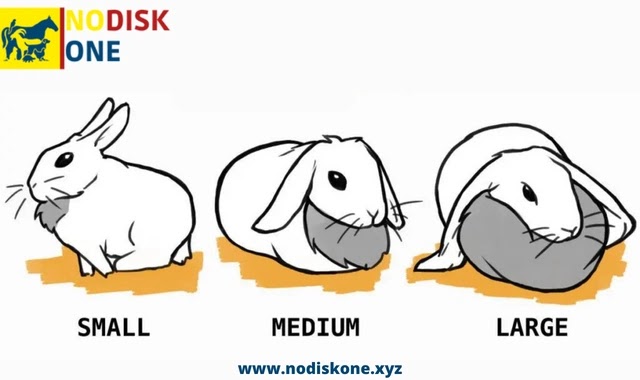 |
| Dewlaps can be found in a wide range of sizes. Larger dewlaps are more common in lop rabbits and larger rabbits. |
A dewlap is a pocket of fatty tissue under a rabbit's chin. Looks like your bunny has a double chin. Baleen is common in female rabbits, which develop them to obtain more nesting material. With the exception of some larger rabbit breeds, males generally do not form baleen.
However, the skin in this area of both male and female rabbits is elastic and therefore can become very large when a rabbit gains weight, even in male rabbits. For this reason, if your male rabbit begins to form a dewlap under his chin, he is likely overweight or obese. Likewise, if a female rabbit's dewlap becomes very large, especially if it has been spayed, this indicates that your rabbit may be overweight.
Causes Of Obesity In Rabbits
While it's possible that there is an underlying condition causing obesity in a rabbit, most of the time the root cause comes down to diet and exercise. Numerous house rabbits consume an unbalanced diet and reside in cramped enclosures that prevent them from getting enough exercise.
Unhealthy Diet
Obesity in rabbits is primarily brought on by a poor diet. It's common for people to give their bunnies too many treats (because they're so cute when they beg) or feed them a diet that's high in pellets and low in essential fiber-dense hay.
Many pet rabbits are fed too many pellets. Rabbits end up with an entire bowl full of pellets during the day. Or maybe those vibrant fruity bits are included in their regular dry food. This is a recipe for weight gain and possible health complications.
 |
| Healthy Diet For Rabbits |
Rabbits do not need a lot of pellets daily. For most rabbits, they should only be given about ¼ to ½ cup of pellets per day, with most of their diet consisting of grass-based hay (like timothy) and some leafy greens costs. The pellets the rabbit receives daily should be a timothy-based mix, no extra fruit pieces!
While it's okay to give your rabbit an occasional treat, you want to avoid giving more than a tablespoon a day. Too many sugary treats (including carrots) can lead to rapid weight gain in rabbits, and they can cause an imbalance in the gut, making the rabbit more susceptible to illness or disease. of a state related to digestion.
Not enough exercise
The other major cause of obesity in pet rabbits is the sedentary lifestyle they often live. Many rabbits are kept in cages that are too small for them and have very little time for exercise and socialization. Most cages sold in pet stores and many sold online are far too small for rabbits.
Rabbit pens should be large enough for a rabbit to do three full hops the full length of the cage. While the ideal enclosure size will vary depending on the size of your rabbit, for an average sized five pound rabbit, you will want an enclosure size of at least 4 feet by 2 feet. This will give your rabbit some room to move around even when you're not home during the day.
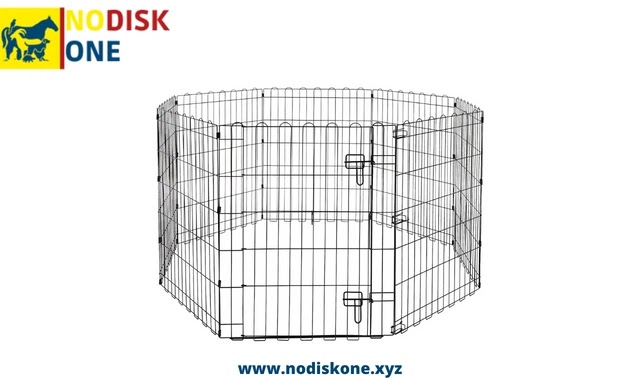 |
| An Exercise Pen For Pets |
I always advise keeping your rabbit in an exercise pen for pets. It gives the rabbit plenty of space and is easy to clean. In addition to an appropriately sized enclosure, rabbits need time in a large area (a room in the house) to exercise during the day. Giving the rabbit 3-4 hours of exercise is ideal, but at least 1-2 hours a day is necessary for its health.
Some rabbits will sit around all day because they are depressed or bored. Rabbits are social animals and need to spend time with people or other rabbits to be happy. They can also get bored and depressed if left in a cage all day with no toys to play with or chew on, leaving them with nothing to do but eat and sleep all day.
Rabbits More At Risk Of Obesity
All rabbits are at risk of becoming obese if they have a poor diet or a sedentary lifestyle, but some are at a higher risk than others. Some toy breeds are more prone to obesity because their small stature allows them to overeat.
Also, many large rabbits were originally meant to be meat rabbits, so they were bred to gain weight quickly and have a calmer, less active demeanor. This is, of course, more of a problem for pet rabbits as it puts these gentle giants at a higher risk of becoming overweight and obese.
Older rabbits are also at risk. As rabbits age, they lose muscle mass and can develop arthritis. This will often cause the older rabbit to be reluctant to move. They may end up gaining weight as their lifestyle becomes less active.
Health Problems Associated With Rabbit Obesity
Obesity is dangerous for our rabbits because of the many health problems that can arise from being overweight. Due to the many conditions and complications that arise, obesity often leads to a reduced lifespan in pet rabbits.
Heart Disease
As with humans, obesity in rabbits puts them at increased risk for heart disease. A rabbit's heart is relatively small compared to its body size, so adding extra weight can put a lot of stress on the heart and cardiovascular system. This puts them at risk of heart attack or heart failure. Before it progresses to an advanced stage, heart disease in rabbits is difficult to detect. The following are signs of heart disease in rabbits:
- Rapid breathing
- Coughing
- Symptoms of pain (sitting in a hunched position)
- Fatigue
- Weakness or dizziness
- Mouth breathing
- Sleep Apnea
- Rapid heartbeat
Poopy Butt And Fly Strike
Soft cecotropes are more prevalent in obese rabbits (called cecal dysbiosis). These pasty droppings stick to the rabbit's bottom. Normally, rabbits could easily keep clean, but obese rabbits will often have a hard time reaching into their fat to clean up the poop that's stuck to their fur.
Over time, this poo eventually forms a ball attached to the bottom of the bunny's butt. This is a condition called Poopy Butt, and it's common in obese and older rabbits who are unable or lack the mobility to clean themselves.
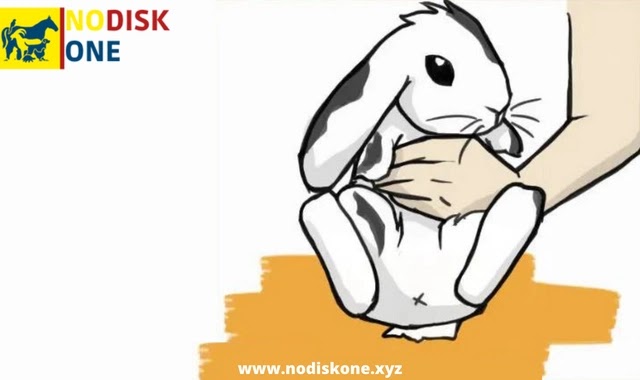 |
| Check your rabbit's butt daily to make sure it is not dirty, so that it does not attract flies. |
Not only does that mean you'll have to do a lot of extra work to keep your bunny's butt clean. Butt poop puts rabbits at increased risk of being the target of fly attacks. This is a gross and deadly condition where a fly will lay eggs on the rabbit, preferring dirty areas. When the eggs hatch, the maggots begin to eat through the rabbit's skin. If left undetected, it can be fatal to rabbits within 48 hours.
Gastrointestinal (GI) stasis
Gastrointestinal stasis is a condition that occurs when a rabbit's intestine slows down or stops altogether. This is especially a danger for obese rabbits, which often have a bacterial imbalance in their gut and have excess fat that puts pressure on their sensitive digestive tract. If symptoms are not detected early enough, gastrointestinal stasis is often a fatal condition for rabbits.
Additionally, obese rabbits are less active, which hinders the passage of food through the digestive system. An overweight rabbit is much more likely to suffer from digestive issues than a healthy weight rabbit. Symptoms of gastrointestinal stasis include:
- Do not eat
- No poop or small malformed poop
- Diarrhea or soft poo
- The stomach rumbles loudly, or no sound comes from the stomac
- Bent posture
- Lack of energy
Sore Hocks (pododermatitis)
Obese rabbits may experience significant foot stress as a result of their extra weight. The heel of a rabbit's foot is called a hock, and it looks a lot like a human's elbow. The skin is just against the bone with little fat or muscle in between.
Obese rabbits put a lot of extra weight on this area, causing blisters or sores to develop. Although not life threatening, it can be a painful condition for rabbits. If you notice sores on your rabbit's heels, you may need to provide him with softer soil (wire cages are especially harmful to rabbit feet) and rub Vaseline on his hocks to help them heal.
Urine scalding
Urine scald is a skin irritation that occurs on a rabbit's buttocks and feet when they cannot completely clean urine. Usually this happens as a result of a urinary tract infection, when a rabbit constantly drools a bit of pee. But it can also happen when the rabbit is too big to clean himself properly.
The rabbit will eventually sit in its urine for long periods of time, causing a rash and irritation. Eventually, the area will start to go bald and lose fur, and it's possible the infection could result from burning urine. This is a very uncomfortable condition for rabbits, which generally prefer to stay clean.
Fatty Liver Disease
Also known as hepatic lipidosis, fatty liver disease occurs when fat builds up in the liver. It usually occurs when a rabbit suddenly becomes anorexic and stops eating (a common symptom of many rabbit diseases). Compared to rabbits that are a healthy weight, this occurs much more frequently in obese rabbits.
When the liver is functioning normally, it stores certain fatty acids to use for energy. But when a rabbit stops eating, especially obese rabbits that already have a larger fat reserve, the liver can start to panic and the fat starts to accumulate, making the rabbit very sick.
It is an extremely serious disease which, if not treated as soon as possible, can lead to liver failure and death. Symptoms of fatty liver disease can appear quickly, so be prepared to act quickly:
- Do not eat
- Weightloss
- Little poop or no poop at all
- Do not drink
- Lack of energy
Arthritis
The excess weight that obese rabbits carry can put extra pressure on their joints. Over time, the joints can become inflamed and cause painful arthritis. Arthritis tends to be particularly severe in the joints that support the rabbit's weight, such as the feet and knees. Thus making them even more reluctant to move than before and compounding the problem.
 |
| Elderly rabbits with weak muscles or arthritis can benefit from having a litter box with a lower entryway. |
Obese and older rabbits tend to have a hard time with arthritis. Not only do they have painful joints, but they also have diminishing muscle mass, which makes it increasingly difficult for them to move. It is therefore difficult to help obese and elderly rabbits lose their excess weight.
Respiratory Diseases
Fat buildup in the body can also put a lot of pressure on a rabbit's lungs, making it harder for them to breathe. Compared to healthy rabbits, overweight rabbits may breathe or pant more heavily. They may even pass out when stressed, a very dangerous position for a rabbit.
Sleep apnea can also affect obese rabbits. A sleep-related breathing disorder that causes sporadic complete cessation of breathing while the rabbit is sleeping.
Bladder Sludge Or Stones
Because obese rabbits tend to be less active, they have an increased risk of developing sludge or bladder stones. This happens when excess calcium forms hardened stones or sand-like sludge in the bladder, making it difficult and painful for the rabbit to urinate. If left unchecked, these conditions can lead to a much more serious bladder or kidney infection.
Although the exact cause of these conditions is not understood, eating the proper diet and exercising daily are the main ways to prevent your rabbit from developing them. Exercise is especially important, as it will keep juices flowing through the rabbit's body, encouraging it to drink and urinate more frequently. Thus, the accumulation of sludge and calcium crystals in the bladder is maintained.
Surgery Is More Difficult On An Overweight Rabbit
An obese rabbit makes surgery exponentially more challenging. What might be a simple procedure for a healthy rabbit is often riddled with complications as doctors try to manage precise surgery with layers of fat in the way. This means surgeries will almost certainly take longer, requiring more anesthesia.
Excess fat can also put pressure on a rabbit's vital organs while the rabbit is lying on its back on the operating table. Even for medical professionals, it can be challenging to correctly diagnose a rabbit. Fat accumulation can make it difficult for doctors to read rabbit x-rays because it can get in the way and be difficult to identify when reading x-rays.
Obesity Treatment
With a healthy diet and regular exercise, obesity is typically reversible. You want to make sure your rabbit doesn't lose weight too quickly because rapid weight loss can cause other health issues in rabbits (like fatty liver disease). The idea is to feed your rabbit a healthy diet and help him lose 1-2 ounces of weight per week until he reaches his goal weight (which will vary depending on breed and size). rabbit size).
Step 1: Consult A Veterinarian
Before making any changes to your rabbit's diet, you should consult your rabbit-savvy veterinarian for advice. Your veterinarian can help you determine your rabbit's ideal weight and can help you safely develop a diet that will help your rabbit slowly lose excess weight.
A veterinarian knowledgeable about rabbits will also be able to check for any underlying disease. Although diet and lifestyle are the most common causes of obesity in rabbits, other conditions may have contributed to the weight gain.
The veterinarian can exclude a possible pregnancy in an unsterilized rabbit. They may look for tumors or other abdominal masses which may also indicate a much more serious condition.
Step 2: Improve Your Rabbit's Ddiet
After consulting your veterinarian and determining your rabbit's target weight, you'll want to take steps to improve his diet. Switching your rabbit to a healthy pellet mix and limiting their daily pellets and treats will help your rabbit slowly shed the extra pounds.
During this time you want to watch your rabbit and watch for any rapid weight loss or refusal to eat. These can be signs of more serious conditions, such as fatty liver disease, and should be treated urgently. The goal is to help your rabbit gradually lose weight a little at a time until it reaches its ideal weight.
Feed Your Rabbit Healthy Pellets
You will want to feed your rabbit a healthier pellet mix. If you are currently feeding your rabbit a fruity rabbit food mix, you will want to change it to timothy pellets.
Oxbow's Garden Select Rabbit Food is something I use and advise. Oxbow is a well-known and respected brand that provides food for rabbits and other small animals. Their pellets meet all of the highest standards for fortified rabbit food, including a very high percentage of fiber, which is good for a rabbit's digestion.
You don't want to give your rabbit a new food all at once, as it can upset his digestive system. So take 3-4 weeks to slowly transition your rabbit from its old unhealthy food to the new one.
 |
| Transition To A New Food |
Give Your Rabbit More Hay
You also want to change your rabbit's diet so that it eats more hay and less pellets. Rather than giving your rabbit an entire bowl full of pellets, limit them to ¼ cup per day (or about 1 tablespoon per pound of your rabbit's ideal weight).
While you're limiting their pellets, you want to make sure they have access to unlimited grass-based hay (like millet hay). It's good for their teeth and high in fiber, making it an essential part of their digestive system.
If your rabbit won't eat his hay despite it being available, he may be fussy. This can happen with rabbits used to eating soft pellets all day. If this is a problem you're facing, then check out my post on fussy rabbits, which is full of ideas for convincing your rabbit to eat their hay.
No Sweet Treats
Even if your rabbit is begging, for now you should stop giving him special treats. This includes sweet produce like strawberries, bananas, and carrots, among other sweet foods. It also includes bagged bunny treats. Particularly yogurt treats can contain a lot of sugar and be detrimental to a rabbit's digestive system.
Step 3: Encourage Activity
You can also help your rabbit lose weight by encouraging him to be more active and engaged. Even if its diet has changed, a sedentary rabbit in a small cage is likely to have many of the same health issues. So count your rabbit's living space and make sure you give him a chance to be happy and active.
Larger Cage
Getting a larger cage for your rabbit will immediately increase the amount he can move during the day. You want to get a cage that measures three to four times your rabbit's overall length.
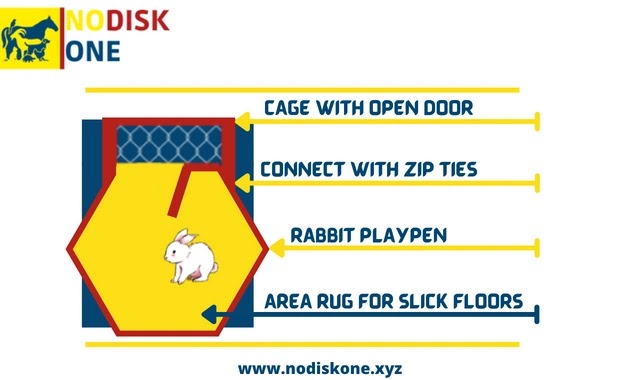 |
| Attach A Rabbit Playpen |
I prefer to have an old enclosure for my rabbits. This gives them a good amount of space and also makes cleaning easier. If your bunny is tethered to their original small cage, you can attach an ex-pen to the front, so you can expand your bunny's space without taking away an area they might call home. .
To encourage more movement, you can also include climbing frames and other enjoyable toys inside their enclosure. Even in a large enclosure, a bored rabbit can sit around all day. Giving them chew toys to throw will encourage them to get up and play.
More Exercise Time
Be sure to give your rabbit plenty of time to exercise every day. Leaving the pen open for several hours at a time will give the rabbit a chance to get outside and exercise, even if he doesn't feel like being active when you first open the cage door. time.
You can also schedule exercise times at the start and end of the day. Rabbits are crepuscular animals, which means they are most active at dawn and dusk of the day. So if you schedule their out-of-cage sessions for when they are naturally more active, it will encourage them to move more and exercise.
Forage For Food
You can also help your rabbit get more exercise by providing them with puzzles that encourage them to seek out their food. I put my rabbit's pellets in a ball which she rolls to get the pellets inside.
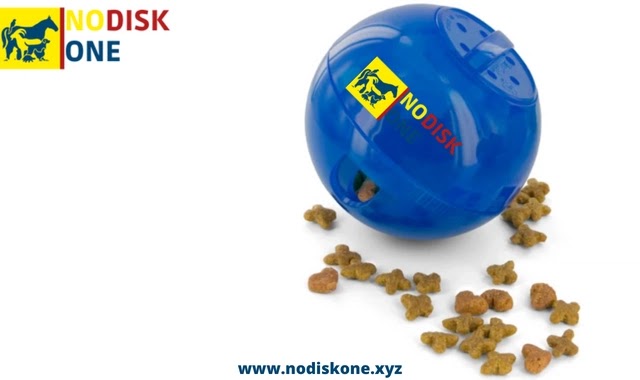 |
| You can use a treat dispenser to administer your rabbit's daily pellets. This will motivate them to get a little more exercise by moving around and foraging for food. |
You can also find puzzle toys where you hide the food and give your bunny a chance to find it on their own. If you're looking for a DIY option, you can use toilet paper rolls and hide food in them. Alternatively, you can sprinkle your rabbit's pellets on his hay so that he is more active in finding the pellets and is encouraged to eat more hay.
Socialization
You'll also want to make sure your rabbit gets enough attention. Rabbits are social creatures and can easily feel lonely and depressed. If you don't have enough time to spend with your rabbit, you should consider finding a partner rabbit to bond with.
When tying rabbits you want to make sure you are careful when introducing the rabbits. Some rabbits tend to be very territorial and will attack other rabbits that come into their area. So be sure to introduce them to a neutral zone and see if they are a compatible pair first.
Related Questions
What signs of underweight do I look for in my rabbit?
An underweight rabbit will have a pointed or protruding spine, hips and ribs. If they are severely underweight, they may have no layers of fat protecting their body and making it difficult or impossible for the rabbit to regulate its body temperature.
Do rabbits lose weight in the summer?
There should be no significant weight loss for a rabbit in the summer. Often rabbits seem to lose weight because they have lost their thicker winter coat, and you can see the rabbit's body more easily with the thinner summer coat.
Only credible sources, such as peer-reviewed studies, are used by Nodisk One to substantiate the information in our articles.

Comments